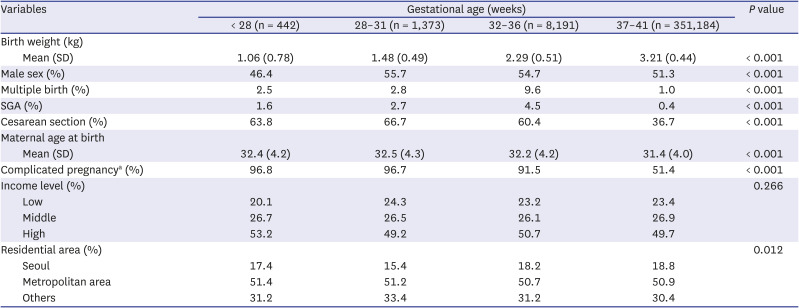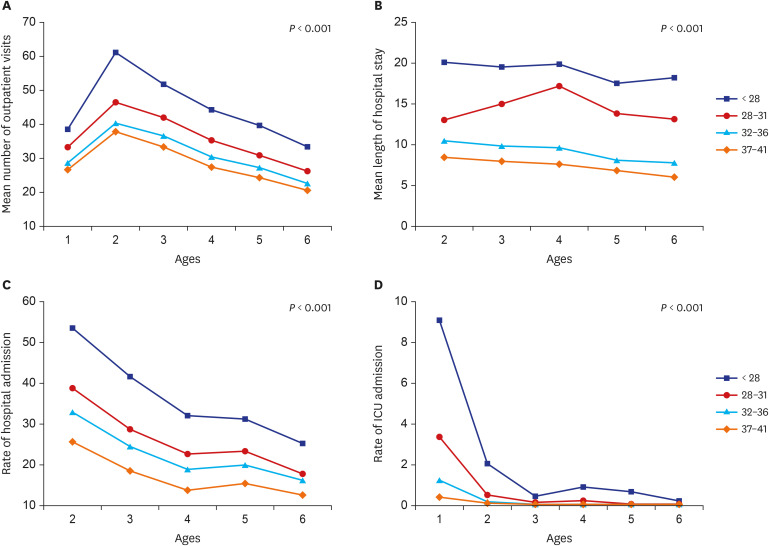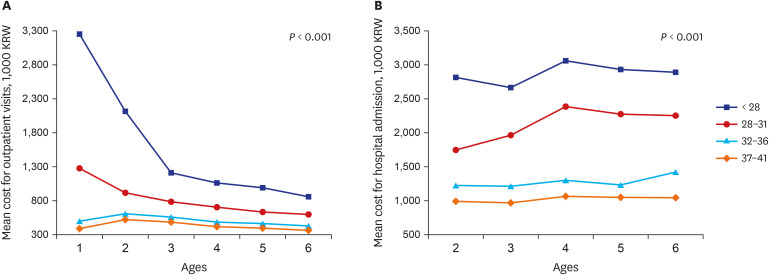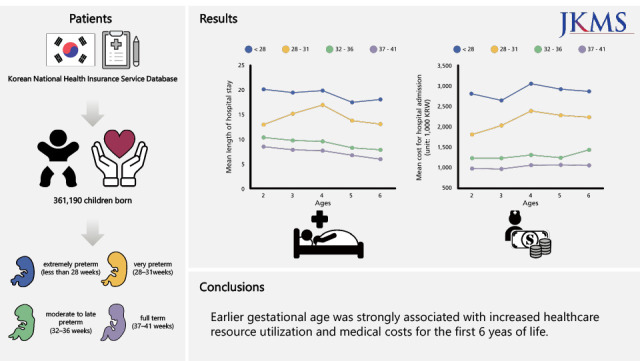2. Glass HC, Costarino AT, Stayer SA, Brett CM, Cladis F, Davis PJ. Outcomes for extremely premature infants. Anesth Analg. 2015; 120(6):1337–1351. PMID:
25988638.
3. The Executive Committee of Korean Neonatal Network. 2019 Korean Neonatal Network Annual Report. Cheongwon, Korea: Korea National Institute of Health;2021.
4. McCormick MC, Litt JS, Smith VC, Zupancic JA. Prematurity: an overview and public health implications. Annu Rev Public Health. 2011; 32(1):367–379. PMID:
21219170.
5. Serenius F, Källén K, Blennow M, Ewald U, Fellman V, Holmström G, et al. Neurodevelopmental outcome in extremely preterm infants at 2.5 years after active perinatal care in Sweden. JAMA. 2013; 309(17):1810–1820. PMID:
23632725.
6. Lee JH, Noh OK, Chang YS. Korean Neonatal Network. Korean Neonatal network. Neonatal outcomes of very low birth weight infants in Korean Neonatal Network from 2013 to 2016. J Korean Med Sci. 2019; 34(5):e40. PMID:
30718992.
7. Talge NM, Holzman C, Wang J, Lucia V, Gardiner J, Breslau N. Late-preterm birth and its association with cognitive and socioemotional outcomes at 6 years of age. Pediatrics. 2010; 126(6):1124–1131. PMID:
21098151.
8. van Baar AL, Vermaas J, Knots E, de Kleine MJ, Soons P. Functioning at school age of moderately preterm children born at 32 to 36 weeks’ gestational age. Pediatrics. 2009; 124(1):251–257. PMID:
19564307.
9. Moster D, Lie RT, Markestad T. Long-term medical and social consequences of preterm birth. N Engl J Med. 2008; 359(3):262–273. PMID:
18635431.
10. Lindström K, Winbladh B, Haglund B, Hjern A. Preterm infants as young adults: a Swedish national cohort study. Pediatrics. 2007; 120(1):70–77. PMID:
17606563.
11. Lakshmanan A, Agni M, Lieu T, Fleegler E, Kipke M, Friedlich PS, et al. The impact of preterm birth <37 weeks on parents and families: a cross-sectional study in the 2 years after discharge from the neonatal intensive care unit. Health Qual Life Outcomes. 2017; 15(1):38. PMID:
28209168.
12. Lee YH, Han K, Ko SH, Ko KS, Lee KU. Taskforce Team of Diabetes Fact Sheet of the Korean Diabetes Association. Data analytic process of a nationwide population-based study using national health information database established by national health insurance service. Diabetes Metab J. 2016; 40(1):79–82. PMID:
26912157.
13. Gong KY. Modularization of Korea’s Development Experience: The Empirical Review of National Health Insurance in Korea. 1st ed. Sejong, Korea: KDI School Pub Pol Manage;2014.
14. Seong SC, Kim YY, Khang YH, Heon Park J, Kang HJ, Lee H, et al. Data resource profile: the national health information database of the national health insurance service in South Korea. Int J Epidemiol. 2017; 46(3):799–800. PMID:
27794523.
15. Kim BI, Lee WR, Kim YK, Park SY. The Analysis of Medical Support Systems and Effectiveness for Preterm Infants. Final Report. Report No.: 11-1352000-001845-01. Seoul, Korea: Division of Population Policy, Office of Ministry of Health and Welfare;2016.
16. Boyle EM, Poulsen G, Field DJ, Kurinczuk JJ, Wolke D, Alfirevic Z, et al. Effects of gestational age at birth on health outcomes at 3 and 5 years of age: population based cohort study. BMJ. 2012; 344:e896. PMID:
22381676.
17. Stephens AS, Lain SJ, Roberts CL, Bowen JR, Nassar N. Survival, hospitalization, and acute-care costs of very and moderate preterm infants in the first 6 years of life: a population-based study. J Pediatr. 2016; 169:61–68.e3. PMID:
26561378.
18. Jo HS, Cho KH, Cho SI, Song ES, Kim BI. Recent changes in the incidence of bronchopulmonary dysplasia among very-low-birth-weight infants in Korea. J Korean Med Sci. 2015; 30(Suppl 1):S81–S87. PMID:
26566362.
19. Townsi N, Laing IA, Hall GL, Simpson SJ. The impact of respiratory viruses on lung health after preterm birth. Eur Clin Respir J. 2018; 5(1):1487214. PMID:
30128088.
20. Trembath A, Laughon MM. Predictors of bronchopulmonary dysplasia. Clin Perinatol. 2012; 39(3):585–601. PMID:
22954271.
21. Johnston KM, Gooch K, Korol E, Vo P, Eyawo O, Bradt P, et al. The economic burden of prematurity in Canada. BMC Pediatr. 2014; 14(1):93. PMID:
24708755.
22. Mangham LJ, Petrou S, Doyle LW, Draper ES, Marlow N. The cost of preterm birth throughout childhood in England and Wales. Pediatrics. 2009; 123(2):e312–e327. PMID:
19171583.
23. Beam AL, Fried I, Palmer N, Agniel D, Brat G, Fox K, et al. Estimates of healthcare spending for preterm and low-birthweight infants in a commercially insured population: 2008–2016. J Perinatol. 2020; 40(7):1091–1099. PMID:
32103158.
24. Johnson S, Marlow N. Early and long-term outcome of infants born extremely preterm. Arch Dis Child. 2017; 102(1):97–102. PMID:
27512082.
25. Natarajan G, Shankaran S. Short- and long-term outcomes of moderate and late preterm infants. Am J Perinatol. 2016; 33(3):305–317. PMID:
26788789.
26. Russell RB, Green NS, Steiner CA, Meikle S, Howse JL, Poschman K, et al. Cost of hospitalization for preterm and low birth weight infants in the United States. Pediatrics. 2007; 120(1):e1–e9. PMID:
17606536.
27. Jin JH, Yoon SW, Song J, Kim SW, Chung HJ. Long-term cognitive, executive, and behavioral outcomes of moderate and late preterm at school age. Clin Exp Pediatr. 2020; 63(6):219–225. PMID:
32024339.
28. Crump C. An overview of adult health outcomes after preterm birth. Early Hum Dev. 2020; 150:105187. PMID:
32948365.










 PDF
PDF Citation
Citation Print
Print




 XML Download
XML Download